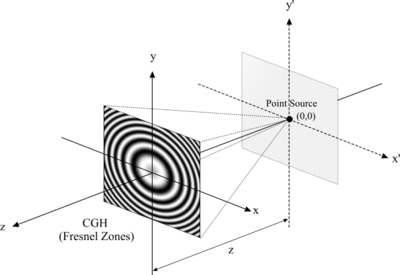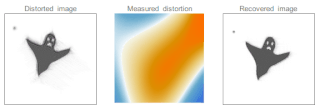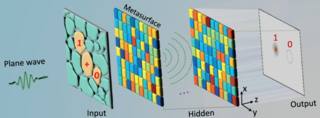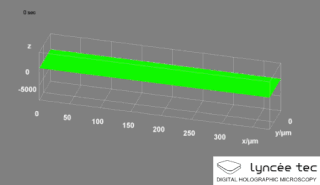Wavefront computation
Computer generated holograms offer important advantages over optical holograms since there is no need for a real object. Because of this breakthrough, a three-dimensional display was expected when the first algorithms were reported at 1966. [4]
Unfortunately, the researchers soon realized that there are noticeable lower and upper bounds in terms of computational speed and image quality and fidelity respectively. Wavefront calculations are computationally very intensive; even with modern mathematical techniques and high-end computing equipment, real-time computation is tricky. There are many different methods for calculating the interference pattern for a CGH. In the following 25 years, many methods for computer-generated holograms were proposed in the fields of holographic information and computational reduction as well as in computational and quantization techniques. [5] [6] [7] [8] [9] [10] [11] The algorithms can be categorized in two main concepts: Fourier transform holograms and point source holograms.
One of the more prevalent methods that can be used to generate phase-only holograms is the Gerchberg-Saxton (GS) algorithm. [12] [13]
Fourier transform method
In the first one, the Fourier transformation is used to simulate the propagation of each plane of depth of the object to the hologram plane. The Fourier transformation concept was first introduced by Byron R. Brown and Adolf W. Lohmann [4] with the detour phase method leading to cell oriented holograms. A coding technique suggested by Burch [14] replaced the cell oriented holograms by point holograms and made this kind of computer generated holograms more attractive. In a Fourier Transform hologram the reconstruction of the image occurs in the far field. This is usually achieved by using the Fourier transforming properties of a positive lens for reconstruction. So there are two steps in this process: computing the light field in the far observer plane, and then Fourier transforming this field back to the lens plane. These holograms are called Fourier Based Holograms. First CGHs based on the Fourier transform could reconstruct only 2D images. Brown and Lohmann [15] introduced a technique to calculate computer generated holograms of 3D objects. Calculation of the light propagation from three-dimensional objects is performed according to the usual parabolic approximation to the Fresnel-Kirchhoff diffraction integral. The wavefront to be reconstructed by the hologram is, therefore, the superposition of the Fourier transforms of each object plane in depth, modified by a quadratic phase factor.
Point source holograms

The second computational strategy is based on the point source concept, where the object is broken down in self-luminous points. An elementary hologram is calculated for every point source and the final hologram is synthesized by superimposing all the elementary holograms. This concept has been first reported by Waters [16] whose major assumption originated with Rogers [17] who recognized that a Fresnel zone plate could be considered a special case of the hologram proposed by Gabor. But, as far as most of the object points were non-zero, the computational complexity of the point-source concept was much higher than in the Fourier transformation concept. Some researchers tried to overcome this drawback by predefining and storing all the possible elementary holograms using special data storage techniques [18] because of the huge capacity that is needed in this case, others by using special hardware. [19]
In the point-source concept the major problem is the trade-off between data storage capacity and computational speed. In particular, algorithms that increase computational speed usually have much greater data storage requirements [18] while algorithms that reduce data storage requirements have high computational complexity [20] [21] [22] (though some optimizations are possible [23] ).
Another concept which leads to point source CGHs is the ray tracing method. Ray tracing is perhaps the simplest method of computer generated holography to visualize. Essentially, the path length difference between the distance a virtual "reference beam" and a virtual "object beam" have to travel is calculated; this will give the relative phase of the scattered object beam.
Over the last three decades, both concepts have made remarkable progress improving computational speed and image quality. However, some technical restraints, like computation and storage capacity, still burden digital holography which makes real-time applications almost impossible with current standard computer hardware.









